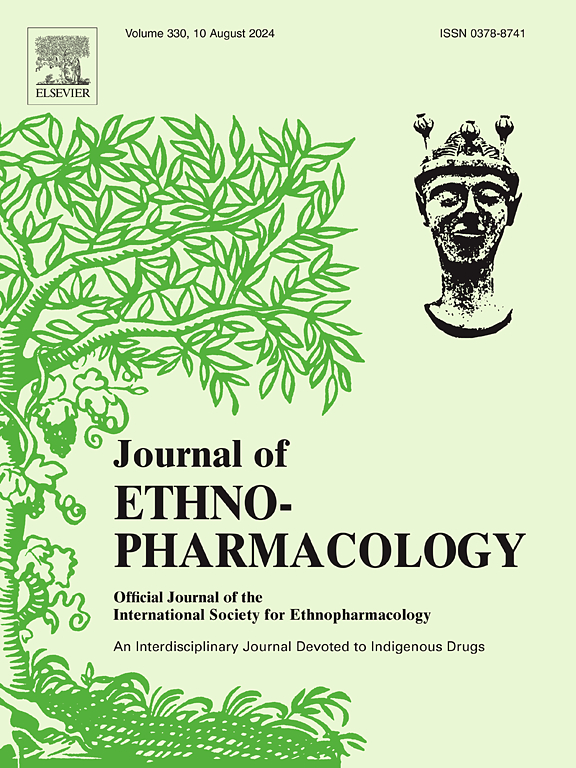Enzyme kinetic and in silico characterization of cytochrome P450 2E1 inhibition by hydro-ethanolic extract of Entada africana and its protective role in acetaminophen-induced hepatotoxicity
IF 5.4
2区 医学
Q1 CHEMISTRY, MEDICINAL
引用次数: 0
Abstract
Ethnopharmacological relevance
Acetaminophen (APAP) poisoning accounts for over 50 % of acute liver failure cases, with N-acetylcysteine remaining the sole antidote despite its limitations. Entada africana, used in ethnomedicine to treat liver disorders, has demonstrated promising antihepatotoxic properties. However, its effects on cytochrome P450 2E1 (CYP2E1) in APAP-toxicity model remain unexplored.
Aims of the study
This study investigated the inhibitory effects of the hydro-ethanolic stem bark extract of E. africana (HEA) on CYP2E1 activity and assessed its hepatoprotective potential against APAP-induced hepatotoxicity.
Materials and methods
Phytochemical profiling of HEA was conducted using UHPLC/MS. Concentration-response and enzyme kinetics studies determined the IC50 and the inhibition mechanism of HEA, respectively. Molecular docking predicted interactions between identified compounds and CYP2E1. The hepatoprotective effects were evaluated through co-treatment of L-02 hepatocytes (10 mM APAP + 25–100 μg/mL HEA or 4-methylpyrazole [4-MP]) and mice (300 mg/kg APAP + 50–200 mg/kg HEA or 4-MP).
Results
HEA inhibited CYP2E1 activity via a mixed-inhibition mechanism, with an IC50 comparable to that of 4-MP, a CYP2E1 inhibitor. Identified phytochemicals including ellagic acid, kaempferol-3-O-glucuronide, and luteolin-7-O-glucoside exhibited strong binding affinities with CYP2E1. In APAP-treated cells, HEA maintained cell viability and preserved membrane integrity. In APAP-intoxicated mice, HEA reduced serum alanine aminotransferase levels, decreased hepatic malondialdehyde content, preserved normal liver architecture, restored hepatic glutathione levels, enhanced superoxide dismutase and catalase activities, and suppressed CYP2E1 expression and activity.
Conclusion
These findings support the ethnopharmacological use of E. africana for liver disorders and highlight its potential as a source of bioactive compounds for the prevention and treatment of drug-induced liver injury.

非洲恩达水乙醇提取物抑制细胞色素P450 2E1的酶动力学和计算机表征及其对对乙酰氨基酚肝毒性的保护作用
对乙酰氨基酚(APAP)中毒占急性肝衰竭病例的50%以上,尽管n -乙酰半胱氨酸有局限性,但它仍然是唯一的解药。在民族医学中用于治疗肝脏疾病的非洲恩达已经显示出有希望的抗肝毒性。然而,在apap毒性模型中,其对细胞色素P450 2E1 (CYP2E1)的影响尚不清楚。研究目的:研究非洲南藤茎皮水乙醇提取物(HEA)对CYP2E1活性的抑制作用,并评估其对apap诱导的肝毒性的肝保护作用。材料与方法采用UHPLC/MS对HEA进行植物化学分析。浓度-反应和酶动力学研究分别确定了HEA的IC50和抑制机制。分子对接预测了鉴定的化合物与CYP2E1之间的相互作用。通过对L-02肝细胞(10 mM APAP + 25-100 μg/mL HEA或4-甲基吡唑[4-MP])和小鼠(300 mg/kg APAP + 50-200 mg/kg HEA或4-MP)联合处理,评估其肝保护作用。结果shea通过混合抑制机制抑制CYP2E1活性,IC50与CYP2E1抑制剂4-MP相当。经鉴定的植物化学物质包括鞣花酸、山奈酚-3- o -葡萄糖苷和木犀草素-7- o -葡萄糖苷与CYP2E1具有很强的结合亲和力。在apap处理的细胞中,HEA维持了细胞活力和膜的完整性。在apap中毒小鼠中,HEA降低血清丙氨酸转氨酶水平,降低肝脏丙二醛含量,保持正常肝脏结构,恢复肝脏谷胱甘肽水平,增强超氧化物歧化酶和过氧化氢酶活性,抑制CYP2E1的表达和活性。结论这些发现支持非洲棘豆在肝脏疾病中的民族药理学应用,并突出了其作为预防和治疗药物性肝损伤的生物活性化合物来源的潜力。
本文章由计算机程序翻译,如有差异,请以英文原文为准。
求助全文
约1分钟内获得全文
求助全文
来源期刊

Journal of ethnopharmacology
医学-全科医学与补充医学
CiteScore
10.30
自引率
5.60%
发文量
967
审稿时长
77 days
期刊介绍:
The Journal of Ethnopharmacology is dedicated to the exchange of information and understandings about people''s use of plants, fungi, animals, microorganisms and minerals and their biological and pharmacological effects based on the principles established through international conventions. Early people confronted with illness and disease, discovered a wealth of useful therapeutic agents in the plant and animal kingdoms. The empirical knowledge of these medicinal substances and their toxic potential was passed on by oral tradition and sometimes recorded in herbals and other texts on materia medica. Many valuable drugs of today (e.g., atropine, ephedrine, tubocurarine, digoxin, reserpine) came into use through the study of indigenous remedies. Chemists continue to use plant-derived drugs (e.g., morphine, taxol, physostigmine, quinidine, emetine) as prototypes in their attempts to develop more effective and less toxic medicinals.
 求助内容:
求助内容: 应助结果提醒方式:
应助结果提醒方式:


